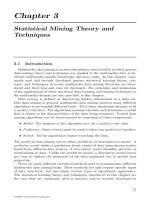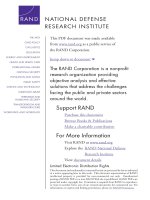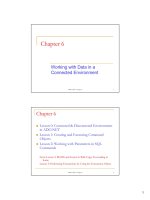- Trang chủ >>
- Đại cương >>
- Kinh tế vĩ mô
data mining a heuristic approach
Bạn đang xem bản rút gọn của tài liệu. Xem và tải ngay bản đầy đủ của tài liệu tại đây (8.34 MB, 562 trang )
TeA
M
YYe
PG
Digitally signed by
TeAM YYePG
DN: cn=TeAM
YYePG, c=US,
o=TeAM YYePG,
ou=TeAM YYePG,
email=yyepg@ms
n.com
Reason: I attest to
the accuracy and
integrity of this
document
Date: 2005.05.07
14:25:04 +08'00'
Data Modeling
Essentials
Simsion-Witt_FM 12/14/04 11:32 PM Page i
This page intentionally left blank
Data Modeling
Essentials
Third Edition
Graeme C. Simsion and Graham C. Witt
AN IMPRINT OF ELSEVIER
AMSTERDAM BOSTON LONDON NEW YORK
OXFORD PARIS SAN DIEGO SAN FRANCISCO
SINGAPORE SYDNEY TOKYO
Simsion-Witt_FM 12/14/04 11:32 PM Page iii
Publishing Director Diane Cerra
Senior Editor Lothlórien Homet
Publishing Services Manager Simon Crump
Project Manager Kyle Sarofeen
Editorial Coordinator Corina Derman
Cover Design Dick Hannus, Hannus Design Associates
Cover Image Creatas
Composition Cepha Imaging Pvt. Ltd.
Copyeditor Broccoli Information Management
Proofreader Jacqui Brownstein
Indexer Broccoli Information Management
Interior printer Maple-Vail Book Manufacturing Group
Cover printer Phoenix Color Corp.
Morgan Kaufmann Publishers is an imprint of Elsevier.
500 Sansome Street, Suite 400, San Francisco, CA 94111
This book is printed on acid-free paper.
© 2005 by Elsevier Inc. All rights reserved.
Designations used by companies to distinguish their products are often claimed as trademarks
or registered trademarks. In all instances in which Morgan Kaufmann Publishers is aware of a
claim, the product names appear in initial capital or all capital letters. Readers, however,
should contact the appropriate companies for more complete information regarding trade-
marks and registration.
No part of this publication may be reproduced, stored in a retrieval system, or transmitted in
any form or by any means—electronic, mechanical, photocopying, scanning, or otherwise—
without prior written permission of the publisher.
Permissions may be sought directly from Elsevier’s Science & Technology Rights Department
in Oxford, UK: phone: (+44) 1865 843830, fax: (+44) 1865 853333, e-mail: permissions
@elsevier.com.uk. You may also complete your request online via the Elsevier homepage
() by selecting “Customer Support” and then “Obtaining Permissions.”
Library of Congress Cataloging-in-Publication Data
Application submitted.
ISBN: 0-12-644551-6
For information on all Morgan Kaufmann publications,
visit our Web site at www.mkp.com or www.books.elsevier.com
Printed in the United States of America
05 06 07 08 09 54321
Simsion-Witt_FM 12/14/04 11:32 PM Page iv
This new edition of Data Modeling Essentials is dedicated
to the memory of our friend and colleague, Robin Wade,
who put the first words on paper for the original edition, and
whose cartoons have illustrated many of our presentations.
Simsion-Witt_FM 12/14/04 11:32 PM Page v
This page intentionally left blank
Contents
Preface xxiii
Part I
The Basics 1
Chapter 1
What Is Data Modeling? 3
1.1 Introduction 3
1.2 A Data-Centered Perspective 3
1.3 A Simple Example 4
1.4 Design, Choice, and Creativity 6
1.5 Why Is the Data Model Important? 8
1.5.1 Leverage 8
1.5.2 Conciseness 9
1.5.3 Data Quality 10
1.5.4 Summary 10
1.6 What Makes a Good Data Model? 10
1.6.1 Completeness 10
1.6.2 NonRedundancy 11
1.6.3 Enforcement of Business Rules 11
1.6.4 Data Reusability 11
1.6.5 Stability and Flexibility 12
1.6.6 Elegance 13
1.6.7 Communication 14
1.6.8 Integration 14
1.6.9 Conflicting Objectives 15
1.7 Performance 15
1.8 Database Design Stages and Deliverables 16
1.8.1 Conceptual, Logical, and Physical Data Models 16
1.8.2 The Three-Schema Architecture and Terminology 17
Simsion-Witt_FM 12/14/04 11:32 PM Page vii
1.9 Where Do Data Models Fit In? 20
1.9.1 Process-Driven Approaches 20
1.9.2 Data-Driven Approaches 20
1.9.3 Parallel (Blended) Approaches 22
1.9.4 Object-Oriented Approaches 22
1.9.5 Prototyping Approaches 23
1.9.6 Agile Methods 23
1.10 Who Should Be Involved in Data Modeling? 23
1.11 Is Data Modeling Still Relevant? 24
1.11.1 Costs and Benefits of Data Modeling
25
1.11.2 Data Modeling and Packaged Software 26
1.11.3 Data Integration 27
1.11.4 Data Warehouses 27
1.11.5 Personal Computing and User-Developed Systems 28
1.11.6 Data Modeling and XML 28
1.11.7 Summary 28
1.12 Alternative Approaches to Data Modeling 29
1.13 Terminology 30
1.14 Where to from Here?—An Overview of Part I 31
1.15 Summary 32
Chapter 2
Basics of Sound Structure 33
2.1 Introduction 33
2.2 An Informal Example of Normalization 34
2.3 Relational Notation 36
2.4 A More Complex Example 37
2.5 Determining Columns 40
2.5.1 One Fact per Column 40
2.5.2 Hidden Data 41
2.5.3 Derivable Data 41
2.5.4 Determining the Primary Key 41
2.6 Repeating Groups and First Normal Form 43
2.6.1 Limit on Maximum Number of Occurrences 43
2.6.2 Data Reusability and Program Complexity 43
2.6.3 Recognizing Repeating Groups 44
2.6.4 Removing Repeating Groups 45
viii
■
Contents
Simsion-Witt_FM 12/14/04 11:32 PM Page viii
2.6.5 Determining the Primary Key of the New Table 46
2.6.6 First Normal Form 47
2.7 Second and Third Normal Forms 47
2.7.1 Problems with Tables in First Normal Form 47
2.7.2 Eliminating Redundancy 48
2.7.3 Determinants 48
2.7.4 Third Normal Form 51
2.8 Definitions and a Few Refinements 53
2.8.1 Determinants and Functional Dependency 53
2.8.2 Primary Keys 54
2.8.3 Candidate Keys 54
2.8.4 A More Formal Definition of Third Normal Form 55
2.8.5 Foreign Keys 55
2.8.6 Referential Integrity 56
2.8.7 Update Anomalies 57
2.8.8 Denormalization and Unnormalization 58
2.8.9 Column and Table Names 59
2.9 Choice, Creativity, and Normalization 60
2.10 Terminology 62
2.11 Summary 63
Chapter 3
The Entity-Relationship Approach 65
3.1 Introduction 65
3.2 A Diagrammatic Representation 65
3.2.1 The Basic Symbols: Boxes and Arrows 66
3.2.2 Diagrammatic Representation of Foreign Keys 67
3.2.3 Interpreting the Diagram 68
3.2.4 Optionality 69
3.2.5 Verifying the Model 70
3.2.6 Redundant Arrows 71
3.3 The Top-Down Approach: Entity-Relationship
Modeling 72
3.3.1 Developing the Diagram Top Down 74
3.3.2 Terminology 75
3.4 Entity Classes 76
3.4.1 Entity Diagramming Convention 77
3.4.2 Entity Class Naming 78
3.4.3 Entity Class Definitions 80
Contents
■
ix
Simsion-Witt_FM 12/14/04 11:32 PM Page ix
3.5 Relationships 82
3.5.1 Relationship Diagramming Conventions 82
3.5.2 Many-to-Many Relationships 87
3.5.3 One-to-One Relationships 92
3.5.4 Self-Referencing Relationships 93
3.5.5 Relationships Involving Three or More Entity Classes 96
3.5.6 Transferability 98
3.5.7 Dependent and Independent Entity Classes 102
3.5.8 Relationship Names 103
3.6 Attributes 104
3.6.1 Attribute Identification and Definition 104
3.6.2 Primary Keys and the Conceptual Model 105
3.7 Myths and Folklore 105
3.7.1 Entity Classes without Relationships 106
3.7.2 Allowed Combinations of Cardinality and Optionality 106
3.8 Creativity and E-R Modeling 106
3.9 Summary 109
Chapter 4
Subtypes and Supertypes 111
4.1 Introduction 111
4.2 Different Levels of Generalization 111
4.3 Rules versus Stability 113
4.4 Using Subtypes and Supertypes 115
4.5 Subtypes and Supertypes as Entity Classes 116
4.5.1 Naming Subtypes 117
4.6 Diagramming Conventions 117
4.6.1 Boxes in Boxes 117
4.6.2 UML Conventions 118
4.6.3 Using Tools That Do Not Support Subtyping 119
4.7 Definitions 119
4.8 Attributes of Supertypes and Subtypes 119
4.9 Nonoverlapping and Exhaustive 120
x
■
Contents
Simsion-Witt_FM 12/14/04 11:32 PM Page x
4.10 Overlapping Subtypes and Roles 123
4.10.1 Ignoring Real-World Overlaps 123
4.10.2 Modeling Only the Supertype 124
4.10.3 Modeling the Roles as Participation in Relationships 124
4.10.4 Using Role Entity Classes and One-to-One Relationships 125
4.10.5 Multiple Partitions 126
4.11 Hierarchy of Subtypes 127
4.12 Benefits of Using Subtypes and Supertypes 128
4.12.1 Creativity 129
4.12.2 Presentation: Level of Detail 129
4.12.3 Communication 130
4.12.4 Input to the Design of Views 132
4.12.5 Classifying Common Patterns 132
4.12.6 Divide and Conquer 133
4.13 When Do We Stop Supertyping and Subtyping? 134
4.13.1 Differences in Identifiers 134
4.13.2 Different Attribute Groups 135
4.13.3 Different Relationships 135
4.13.4 Different Processes 136
4.13.5 Migration from One Subtype to Another 136
4.13.6 Communication 136
4.13.7 Capturing Meaning and Rules 137
4.13.8 Summary 137
4.14 Generalization of Relationships 138
4.14.1 Generalizing Several One-to-Many Relationships to a Single Many-to-
Many Relationship 138
4.14.2 Generalizing Several One-to-Many Relationships
to a Single One-to-Many Relationship 139
4.14.3 Generalizing One-to-Many and Many-to-Many Relationships 141
4.15 Theoretical Background 142
4.16 Summary 143
Chapter 5
Attributes and Columns 145
5.1 Introduction 145
5.2 Attribute Definition 146
Contents
■
xi
Simsion-Witt_FM 12/14/04 11:32 PM Page xi
5.3 Attribute Disaggregation: One Fact per Attribute 147
5.3.1 Simple Aggregation 148
5.3.2 Conflated Codes 150
5.3.3 Meaningful Ranges 151
5.3.4 Inappropriate Generalization 151
5.4 Types of Attributes 152
5.4.1 DBMS Datatypes 152
5.4.2 The Attribute Taxonomy in Detail 154
5.4.3 Attribute Domains 158
5.4.4 Column Datatype and Length Requirements 162
5.4.5 Conversion Between External and Internal Representations 166
5.5 Attribute Names 166
5.5.1 Objectives of Standardizing Attribute Names 166
5.5.2 Some Guidelines for Attribute Naming 168
5.6 Attribute Generalization 171
5.6.1 Options and Trade-Offs 171
5.6.2 Attribute Generalization Resulting from Entity Generalization 172
5.6.3 Attribute Generalization within Entity Classes 173
5.6.4 “First Among Equals” 177
5.6.5 Limits to Attribute Generalization 178
5.7 Summary 180
Chapter 6
Primary Keys and Identity 183
6.1 Basic Requirements and Trade-Offs 183
6.2 Basic Technical Criteria 185
6.2.1 Applicability 185
6.2.2 Uniqueness 186
6.2.3 Minimality 188
6.2.4 Stability 189
6.3 Surrogate Keys 191
6.3.1 Performance and Programming Issues 191
6.3.2 Matching Real-World Identifiers 191
6.3.3 Should Surrogate Keys Be Visible? 192
6.3.4 Subtypes and Surrogate Keys 193
6.4 Structured Keys 194
6.4.1 When to Use Structured Keys 196
6.4.2 Programming and Structured Keys 197
6.4.3 Performance Issues with Structured Keys 198
6.4.4 Running Out of Numbers 199
xii
■
Contents
Simsion-Witt_FM 12/14/04 11:32 PM Page xii
6.5 Multiple Candidate Keys 201
6.5.1 Choosing a Primary Key 201
6.5.2 Normalization Issues 201
6.6 Guidelines for Choosing Keys 202
6.6.1 Tables Implementing Independent Entity Classes 202
6.6.2 Tables Implementing Dependent Entity Classes and Many-to-Many
Relationships 203
6.7 Partially-Null Keys 204
6.8 Summary 206
Chapter 7
Extensions and Alternatives 207
7.1 Introduction 207
7.2 Extensions to the Basic E-R Approach 209
7.2.1 Introduction 209
7.2.2 Advanced Attribute Concepts 210
7.3 The Chen E-R Approach 216
7.3.1 The Basic Conventions 216
7.3.2 Relationships with Attributes 217
7.3.3 Relationships Involving Three or More Entity Classes 217
7.3.4 Roles 218
7.3.5 The Weak Entity Concept 219
7.3.6 Chen Conventions in Practice 220
7.4 Using UML Object Class Diagrams 220
7.4.1 A Conceptual Data Model in UML 221
7.4.2 Advantages of UML 222
7.5 Object Role Modeling 227
7.6 Summary 228
Part II
Putting It Together 229
Chapter 8
Organizing the Data Modeling Task 231
8.1 Data Modeling in the Real World 231
8.2 Key Issues in Project Organization 233
8.2.1 Recognition of Data Modeling 233
8.2.2 Clear Use of the Data Model 234
Contents
■
xiii
Simsion-Witt_FM 12/14/04 11:32 PM Page xiii
8.2.3 Access to Users and Other Business Stakeholders 234
8.2.4 Conceptual, Logical, and Physical Models 235
8.2.5 Cross-Checking with the Process Model 236
8.2.6 Appropriate Tools 237
8.3 Roles and Responsibilities 238
8.4 Partitioning Large Projects 240
8.5 Maintaining the Model 242
8.5.1 Examples of Complex Changes 242
8.5.2 Managing Change in the Modeling Process 247
8.6 Packaging It Up 248
8.7 Summary 249
Chapter 9
The Business Requirements 251
9.1 Purpose of the Requirements Phase 251
9.2 The Business Case 253
9.3 Interviews and Workshops 254
9.3.1 Should You Model in Interviews and Workshops? 255
9.3.2 Interviews with Senior Managers 256
9.3.3 Interviews with Subject Matter Experts 257
9.3.4 Facilitated Workshops 257
9.4 Riding the Trucks 258
9.5 Existing Systems and Reverse
Engineering 259
9.6 Process Models 261
9.7 Object Class Hierarchies 261
9.7.1 Classifying Object Classes 263
9.7.2 A Typical Set of Top-Level Object Classes 265
9.7.3 Developing an Object Class Hierarchy 267
9.7.4 Potential Issues 270
9.7.5 Advantages of the Object Class Hierarchy Technique 270
9.8 Summary 270
xiv
■
Contents
Simsion-Witt_FM 12/14/04 11:32 PM Page xiv
Chapter 10.
Conceptual Data Modeling 273
10.1 Designing Real Models 273
10.2 Learning from Designers in Other Disciplines 275
10.3 Starting the Modeling 276
10.4 Patterns and Generic Models 277
10.4.1 Using Patterns 277
10.4.2 Using a Generic Model 278
10.4.3 Adapting Generic Models from Other Applications 279
10.4.4 Developing a Generic Model 282
10.4.5 When There Is Not a Generic Model 284
10.5 Bottom-Up Modeling 285
10.6 Top-Down Modeling 288
10.7 When the Problem Is Too Complex 288
10.8 Hierarchies, Networks, and Chains 290
10.8.1 Hierarchies 291
10.8.2 Networks (Many-to-Many Relationships) 293
10.8.3 Chains (One-to-One Relationships) 295
10.9 One-to-One Relationships 295
10.9.1 Distinct Real-World Concepts 296
10.9.2 Separating Attribute Groups 297
10.9.3 Transferable One-to-One Relationships 298
10.9.4 Self-Referencing One-to-One Relationships 299
10.9.5 Support for Creativity 299
10.10 Developing Entity Class Definitions 300
10.11 Handling Exceptions 301
10.12 The Right Attitude 302
10.12.1 Being Aware 303
10.12.2 Being Creative 303
10.12.3 Analyzing or Designing 303
10.12.4. Being Brave 304
10.12.5 Being Understanding and Understood 304
10.13 Evaluating the Model 305
10.14 Direct Review of Data Model Diagrams 306
Contents
■
xv
Simsion-Witt_FM 12/14/04 11:32 PM Page xv
10.15 Comparison with the Process Model 308
10.16 Testing the Model with Sample Data 308
10.17 Prototypes 309
10.18 The Assertions Approach 309
10.18.1 Naming Conventions 310
10.18.2 Rules for Generating Assertions 311
10.19 Summary 319
Chapter 11
Logical Database Design 321
11.1 Introduction 321
11.2 Overview of the Transformations
Required 322
11.3 Table Specification 325
11.3.1 The Standard Transformation 325
11.3.2 Exclusion of Entity Classes from the Database 325
11.3.3 Classification Entity Classes 325
11.3.4 Many-to-Many Relationship Implementation 326
11.3.5 Relationships Involving More Than Two Entity Classes 328
11.3.6 Supertype/Subtype Implementation 328
11.4 Basic Column Definition 334
11.4.1 Attribute Implementation: The Standard Transformation 334
11.4.2 Category Attribute Implementation 335
11.4.3 Derivable Attributes 336
11.4.4 Attributes of Relationships 336
11.4.5 Complex Attributes 337
11.4.6 Multivalued Attribute Implementation 337
11.4.7 Additional Columns 339
11.4.8 Column Datatypes 340
11.4.9 Column Nullability 340
11.5 Primary Key Specification 341
11.6 Foreign Key Specification 342
11.6.1 One-to-Many Relationship Implementation 343
11.6.2 One-to-One Relationship Implementation 346
11.6.3 Derivable Relationships 347
11.6.4 Optional Relationships 348
xvi
■
Contents
Simsion-Witt_FM 12/14/04 11:32 PM Page xvi
11.6.5 Overlapping Foreign Keys 350
11.6.6 Split Foreign Keys 352
11.7 Table and Column Names 354
11.8 Logical Data Model Notations 355
11.9 Summary 357
Chapter 12
Physical Database Design 359
12.1 Introduction 359
12.2 Inputs to Database Design 361
12.3 Options Available to the Database Designer 362
12.4 Design Decisions Which Do Not Affect Program Logic 363
12.4.1 Indexes 363
12.4.2 Data Storage 370
12.4.3 Memory Usage 372
12.5 Crafting Queries to Run Faster 372
12.5.1 Locking 373
12.6 Logical Schema Decisions 374
12.6.1 Alternative Implementation of Relationships 374
12.6.2 Table Splitting 374
12.6.3 Table Merging 376
12.6.4 Duplication 377
12.6.5 Denormalization 378
12.6.6 Ranges 379
12.6.7 Hierarchies 380
12.6.8 Integer Storage of Dates and Times 382
12.6.9 Additional Tables 383
12.7 Views 384
12.7.1 Views of Supertypes and Subtypes 385
12.7.2 Inclusion of Derived Attributes in Views 385
12.7.3 Denormalization and Views 385
12.7.4 Views of Split and Merged Tables 386
12.8 Summary 386
Contents
■
xvii
Simsion-Witt_FM 12/14/04 11:32 PM Page xvii
Part III
Advanced Topics 389
Chapter 13
Advanced Normalization 391
13.1 Introduction 391
13.2 Introduction to the Higher Normal Forms 392
13.2.1 Common Misconceptions 392
13.3 Boyce-Codd Normal Form 394
13.3.1 Example of Structure in 3NF but not in BCNF 394
13.3.2 Definition of BCNF 396
13.3.3 Enforcement of Rules versus BCNF 397
13.3.4 A Note on Domain Key Normal Form 398
13.4 Fourth Normal Form (4NF) and
Fifth Normal Form (5NF) 398
13.4.1 Data in BCNF but not in 4NF 399
13.4.2 Fifth Normal Form (5NF) 401
13.4.3 Recognizing 4NF and 5NF Situations 404
13.4.4 Checking for 4NF and 5NF with the
Business Specialist 405
13.5 Beyond 5NF: Splitting Tables Based on
Candidate Keys 407
13.6 Other Normalization Issues 408
13.6.1 Normalization and Redundancy 408
13.6.2 Reference Tables Produced by Normalization 410
13.6.3 Selecting the Primary Key after Removing Repeating Groups 411
13.6.4 Sequence of Normalization and
Cross-Table Anomalies 414
13.7 Advanced Normalization in Perspective 415
13.8 Summary 416
Chapter 14
Modeling Business Rules 417
14.1 Introduction 417
14.2 Types of Business Rules 418
14.2.1 Data Rules 418
14.2.2 Process Rules 420
xviii
■
Contents
Simsion-Witt_FM 12/14/04 11:32 PM Page xviii
14.2.3 What Rules are Relevant to the Data Modeler? 420
14.3 Discovery and Verification of Business Rules 420
14.3.1 Cardinality Rules 420
14.3.2 Other Data Validation Rules 421
14.3.3 Data Derivation Rules 421
14.4 Documentation of Business Rules 422
14.4.1 Documentation in an E-R Diagram 422
14.4.2 Documenting Other Rules 422
14.4.3 Use of Subtypes to Document Rules 424
14.5 Implementing Business Rules 427
14.5.1 Where to Implement Particular Rules 428
14.5.2 Implementation Options: A Detailed Example 433
14.5.3 Implementing Mandatory Relationships 436
14.5.4 Referential Integrity 438
14.5.5 Restricting an Attribute to a Discrete Set of Values 439
14.5.6 Rules Involving Multiple Attributes 442
14.5.7 Recording Data That Supports Rules 442
14.5.8 Rules That May Be Broken 443
14.5.9 Enforcement of Rules Through Primary Key Selection 445
14.6 Rules on Recursive Relationships 446
14.6.1 Types of Rules on Recursive Relationships 447
14.6.2 Documenting Rules on Recursive Relationships 449
14.6.3 Implementing Constraints on Recursive Relationships 449
14.6.4 Analogous Rules in Many-to-Many Relationships 450
14.7 Summary 450
Chapter 15
Time-Dependent Data 451
15.1 The Problem 451
15.2 When Do We Add the Time Dimension? 452
15.3 Audit Trails and Snapshots 452
15.3.1 The Basic Audit Trail Approach 453
15.3.2 Handling Nonnumeric Data 458
15.3.3 The Basic Snapshot Approach 458
15.4 Sequences and Versions 462
15.5 Handling Deletions 463
15.6 Archiving 463
Contents
■
xix
Simsion-Witt_FM 12/14/04 11:32 PM Page xix
15.7 Modeling Time-Dependent Relationships 464
15.7.1 One-to-Many Relationships 464
15.7.2 Many-to-Many Relationships 466
15.7.3 Self-Referencing Relationships 468
15.8 Date Tables 469
15.9 Temporal Business Rules 469
15.10 Changes to the Data Structure 473
15.11 Putting It into Practice 473
15.12 Summary 474
Chapter 16
Modeling for Data Warehouses and
Data Marts 475
16.1 Introduction 475
16.2 Characteristics of Data Warehouses and Data Marts 478
16.2.1 Data Integration: Working with Existing Databases 478
16.2.2 Loads Rather Than Updates 478
16.2.3 Less Predictable Database “Hits” 479
16.2.4 Complex Queries—Simple Interface 479
16.2.5 History 480
16.2.6 Summarization 480
16.3 Quality Criteria for Warehouse and Mart Models 480
16.3.1 Completeness 480
16.3.2 Nonredundancy 481
16.3.3 Enforcement of Business Rules 482
16.3.4 Data Reusability 482
16.3.5 Stability and Flexibility 482
16.3.6 Simplicity and Elegance 483
16.3.7 Communication Effectiveness 483
16.3.8 Performance 483
16.4 The Basic Design Principle 483
16.5 Modeling for the Data Warehouse 484
16.5.1 An Initial Model 484
16.5.2 Understanding Existing Data 485
16.5.3 Determining Requirements 485
16.5.4 Determining Sources and Dealing with Differences 485
16.5.5 Shaping Data for Data Marts 487
xx
■
Contents
Simsion-Witt_FM 12/14/04 11:32 PM Page xx
16.6 Modeling for the Data Mart 488
16.6.1 The Basic Challenge 488
16.6.2 Multidimensional Databases, Stars and Snowflakes 488
16.6.3 Modeling Time-Dependent Data 494
16.7 Summary 496
Chapter 17
Enterprise Data Models and Data Management 499
17.1 Introduction 499
17.2 Data Management 500
17.2.1 Problems of Data Mismanagement 500
17.2.2 Managing Data as a Shared Resource 501
17.2.3 The Evolution of Data Management 501
17.3 Classification of Existing Data 503
17.4 A Target for Planning 504
17.5 A Context for Specifying New Databases 506
17.5.1 Determining Scope and Interfaces 506
17.5.2 Incorporating the Enterprise Data Model in the Development
Life Cycle 506
17.6 Guidance for Database Design 508
17.7 Input to Business Planning 508
17.8 Specification of an Enterprise Database 509
17.9 Characteristics of Enterprise Data Models 511
17.10 Developing an Enterprise Data Model 512
17.10.1 The Development Cycle 512
17.10.2 Partitioning the Task 513
17.10.3 Inputs to the Task 514
17.10.4 Expertise Requirements 515
17.10.5 External Standards 515
17.11 Choice, Creativity, and Enterprise Data Models 516
17.12 Summary 517
Further Reading 519
Index 525
Contents
■
xxi
Simsion-Witt_FM 12/14/04 11:32 PM Page xxi
This page intentionally left blank
xxiii
Preface
Early in the first edition of this book, I wrote “data modeling is not optional;
no database was ever built without at least an implicit model, just as no
house was ever built without a plan.” This would seem to be a self-evident
truth, but I spelled it out explicitly because I had so often been asked by
systems developers “what is the value of data modeling?” or “why should
we do data modeling at all?”.
From time to time, I see that a researcher or practitioner has referenced
Data Modeling Essentials, and more often than not it is this phrase that they
have quoted. In writing the book, I took strong positions on a number of
controversial issues, and at the time would probably have preferred that
attention was focused on these. But ten years later, the biggest issue in data
modeling remains the basic one of recognizing it as a fundamental activity—
arguably the single most important activity — in information systems design,
and a basic competency for all information systems professionals.
The goal of this book, then, is to help information systems professionals
(and for that matter, casual builders of information systems) to acquire that
competency in data modeling. It differs from others on the topic in several
ways.
First, it is written by and for practitioners: it is intended as a practical
guide for both specialist data modelers and generalists involved in the
design of commercial information systems. The language and diagramming
conventions reflect industry practice, as supported by leading modeling
tools and database management systems, and the advice takes into account
the realities of developing systems in a business setting. It is gratifying to
see that this practical focus has not stopped a number of universities and
colleges from adopting the book as an undergraduate and postgraduate
text: a teaching pack for this edition is available from Morgan Kaufmann at
www.mkp.com/companions/0126445516.
Second, it recognizes that data modeling is a design activity, with oppor-
tunities for choice and creativity. For a given problem there will usually
be many possible models that satisfy the business requirements and conform
to the rules of sound design. To select the best model, we need to consider
a variety of criteria, which will vary in importance from case to case.
Throughout the book, the emphasis is on understanding the merits of differ-
ent solutions, rather than prescribing a single “correct” answer.
Simsion-Witt_FM 12/14/04 11:32 PM Page xxiii









